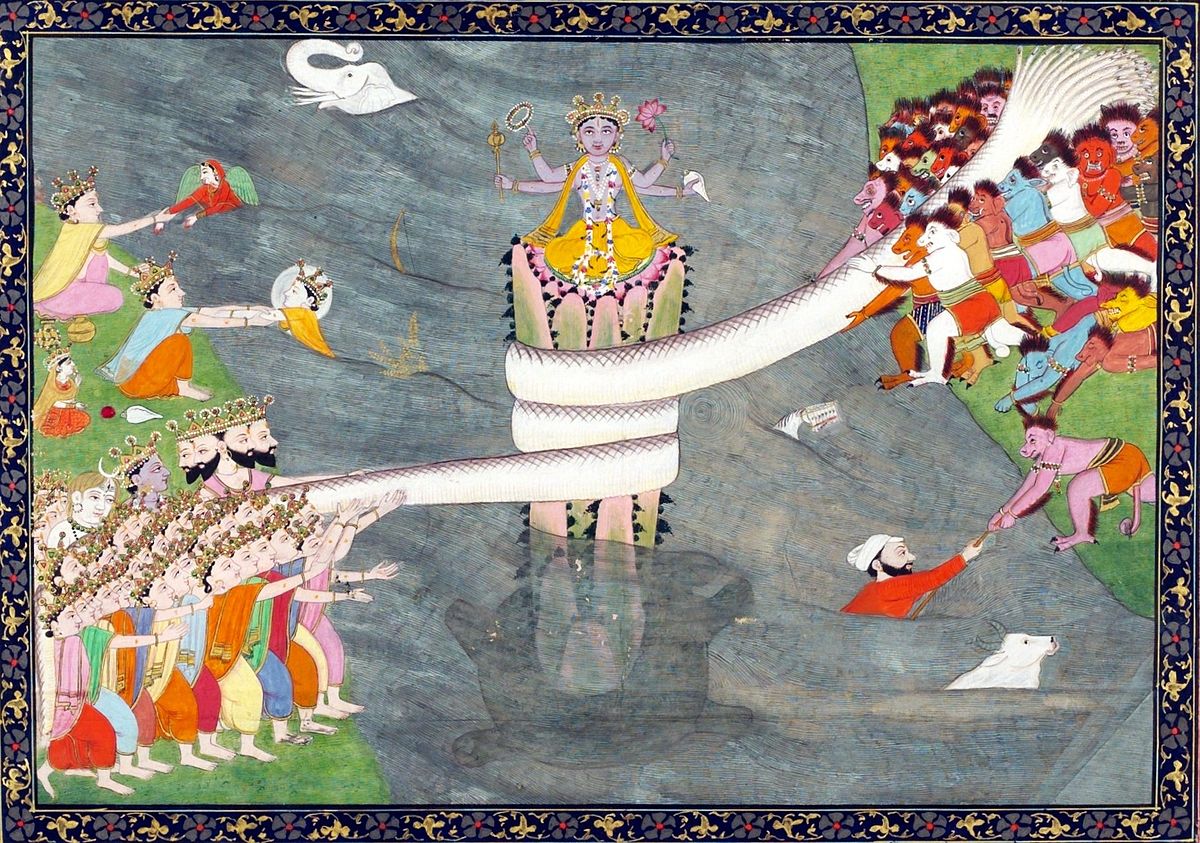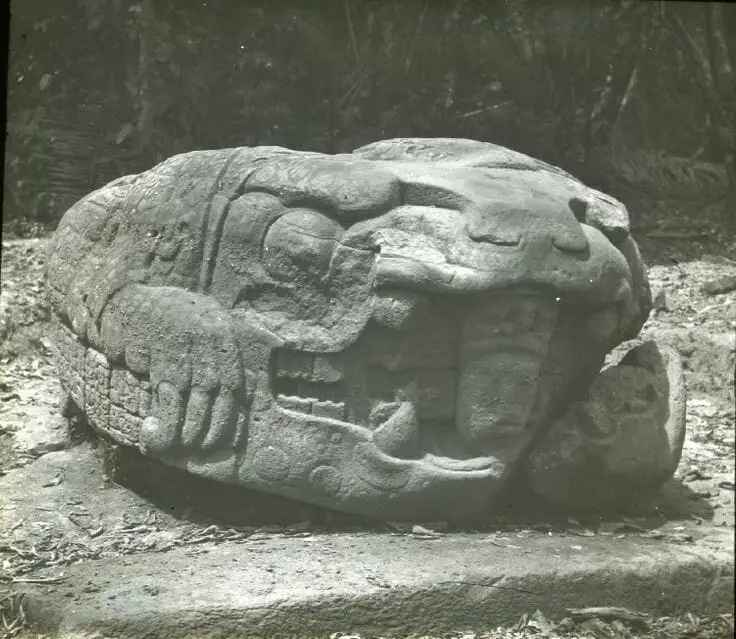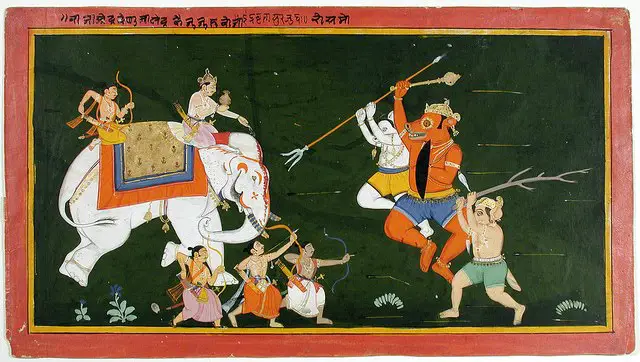Starting from Airāvata and the mythology of the "blending of the Ocean of Milk" and then reaching Ganesha, Giuseppe Acerbi aims to identify some esoteric correspondences between the elephant-headed divinities of ancient India, Iran, Japan and the Americas.
di Joseph Acerbi
orig. published on the Author's blog On the slopes of Mount Meru
and later republished on The Lost Image
All started by Airavata, the Celestial Elephant (of the Clouds), white pachyderm born from the flapping of the Ocean of Milk. What this ocean was has never been very clear to Hindu scholars, but tackling the subject without the usual academic prejudice - as some did at the time [1] - we would come to discover that the legendary flapping would actually be nothing more than the mythical transposition of a phenomenon of pole shift which, borrowing an expression of Grossato, we could define "Polar commuting". Without, however, limiting ourselves to the partial astronomical reductionism of the two authors cited, who, although excellent in their textual analysis, were sinful of scientism; in fact, despite the recognition of the importance of astrology in antiquity, they consequently did not make the necessary effort to distinguish it from astronomy.
Polar commuting, which has clearly shown the Hancockian school with effective and documented video recordings, is strictly connected to the equinoctial precession; a retrogradation phenomenon which, in turn, causes the Solar (or Lunar) Zodiac to go backwards by 1 ° every 72 years and which therefore can easily be taken as an indication of the passing of millennia. The problem, however, is that even after adding that explanation, things don't end there. That is, the astral dynamics - we use this neutral terminology in order not to credit Hipparchus, alleged Hellenic discoverer of the processional law around 130 BC according to historians of science, and Greek astronomy the discovery of a celestial phenomenon already well known for a long time to See as for Hermeticism - in the past it did not have a purely descriptive sense; but it was instead connected to certain time cycles, which appropriately delimited it and highlighted its intrinsic symbolic potential, capable of soliciting a vast knowledge of the cosmos.
In other words, the whole story of the oceanic shock is inherent in a primordial picture of events which is precisely the II Avataric Cycle. See our article on the subject [2]. If he is involved in it the snake Vasuki, var. from SelfSa-Ananta, it is by implicit reference to North Dragon, the circumpolar asterism dominating the arctic pivot of the celestial vault in that cycle and generally placed at the center of the aforementioned pendular movement. According to what can be deduced from a simple astronomical calculation, at the end of this cycle, as it happened in our times in the year XNUMX (although appearances deceive us), there was a passage of dominion from the Dragon to the Polaris. Of course, with all the related mythic implications.
The cosmological basis inApocalypse Johannine of the rising of the 10 Horned Beast, incarnation of Chronos-Aion, it is all here, although the misleading allegorical interpretation of the text itself alludes to 10 cities. Misleading, it is natural, for unbelievers or for the profane such as simple believers; that, if they know how to go beyond the letter, they do it only on this level. If Vasuki was precisely the Dragon, the Ocean could only be the Arctic. How and where was life possible there or in the surrounding area and what were the lands that emerged in those millennia (the second cycle refers to the Northeast of the world, not to the Hyperborean Earth, that is to an ideal geographical arc that roughly goes from Eastern Siberia almost to Polynesia and from that area to Alaska) it is not our job to establish there. The dating period to be taken into consideration, astrally calculated, corresponds approximately to 56-50.000 years a. the EV Nor can scriptural themes be manipulated to one's liking: the essential thing is to try to understand them in their profound meanings, while formally adhering to the letter.
The theme we are addressing here is therefore simply one, the birth chronology of Airavata and therefore of the elephant symbol. We have explained elsewhere [3] is what appears in India as a peculiar attribution of that land constitutes, beyond any illusory ethnocentrism, a motif undoubtedly endowed with a general value, since it refers to times in which territorial states did not yet exist and, according to what both the philological study of the Bible and the modern prehistoric study confirm, the "confusion of languages" had not yet occurred; in other words, translating the theme in terms that are understandable to us, the partial eclipse of the universal symbolic language. It is a generalized shamanic culture throughout the entire globe [4] which, of course, we refer to. According to the avataric axiom within each cycle there would be a given dominant Direction, which would move from time to time in the solar direction. We repeat, the direction in this case would be the Northeast. If we want to understand myths we must stick to the logic inherent in them rather than determine whether they are true or not, which a serious scholar should always take for granted. It is no coincidence that the ancients conceived myth as a true story, albeit spiced with fantastic elements.

The fact that a similar mythology can be traced in areas adjacent to the one summarily outlined: Middle East, Central-Southern Asia, Eastern Asia and North America. Just think about the div Akvan neo-Iranian (adv. Aka Manah), elephant-headed, many-fanged demon, despite the Persian miniatures portraying him as a generic monster [5]; of the Deccan we have already said, but also in the Japanese and North American area, stories have long been known that recall from the corresponding Indian myth [6]. Except that in the latter case, scholars of pre-Columbian culture had clumsily mistaken an elephant head for a tapir head, since the discovery of mammoth fossils has not yet occurred in America, certainly transmigrated there by arctic routes. After that the enigma was cleared up without having to resort to Atlantis, an argument that at first undermined the due recognition of the presence of pachyderms in Mayan art. The mere fact of having entered the debate on the location and existence of the lost continent had hitherto prevented the question from being resolved with hindsight. [7].
In India the legend of Ocean and Amṛtama (n) thana, the Oceanic shaking and the consequent production of Ambrosia by the Kūrmavatara, first appears in Brahmaṇa, then in the epic and in numerous pureāṇa. It is the Serpent (Vasuki) to uproot the Merumandara, the Cosmic Mountain used as a churn to blend the ocean as if it were milk to obtain butter, and the Turtle (Kūrma) to act as the lower pivot. The former also acts as a chord in the flapping, while Deva (Constellations) ed Asura (Planets) hold head and tail respectively. The cosmological meaning having already been elementary clarified, it is clear what the spiritual meaning of the operation could be beyond the letter; since Kurma is the II Avatara, having the task of keeping the Dharma despite the general disruption. On the other hand, it is less easy to understand what the meaning of secondary gifts is, apart from Ambrosia. Or the coming forth of the White Horse, I killedḥśravas, certainly originally an onager similar to Avestan judging by the expression. The reciprocal reference however goes to Canopus, as the Antarctic pole opposite to the Dragon.
Airavata, the White Mastodon with 4 Fangs, alludes vice versa to the solstices and equinoxes, which then for the first time evidently became objects of worship. Other gifts, which we are not discussing there for the sake of brevity, are in fact: the Sun, the Moon, the Cow of Plenty (Surabhi, probable image of a new earth, the first treasure to emerge from the upheaval), the heavenly Goddess of Abundance (Wedī, the Goddess of Waters - Varuṇī, i.e. Venus - and the apsaras - Sirens, as essences of the waters). In addition, of course, as mentioned above, toAmṛta (Immortality) or Sum (Light) what to say if you want and al Kaustubha (the Gem of Desires = Heart). This indicates the first, active form of meditation and consequent contemplation. On the other hand, it simultaneously comes out il Kalakūta, a terrible poison wreaking havoc on the entire universe if it wasn't drunk by Śiva; this poison, according to J. Gonda, would be nothing other than "the mortal principle of natural life". At the same time the texts speak ofa conflagration with winds full of smoke and flames, which today we would say pyroplastic, only later tempered by abundant rains; and, consequently, of a remarkable moría of terrestrial and aquatic animals. Let us remember for the avoidance of doubt that Hindu cosmology predicts such events every 6.480 years or so, that is, at the end of Yuga (Aeons), when the Seven Planets (Saptagraha) all gather in the zodiac sign of Taurus. As it happened recently in the year XNUMX.

In Japan there is a version of the myth that follows the Indian one, perhaps arrived via the Buddhist route; but also in the Shinto context, you see Ko-ji-ki e Nihon-gi, we find the demiurgic couple izanagi-izanami intent on stirring the primeval waters to shed and form the earth. Again, this is the typical legend illustrating a secondary creation.
With the Toltecs, as the Cortes Code, the same mythical scenario appears; However the role of the Tortoise and the Serpent is directionally reversed (one above and the other below), demonstrating that the true original meaning had been irretrievably lost [8]. Head and tail of the snake, like a rope, are held for the occasion by a elephant-headed god (chack, god of rain) on one side and two dark gods on the other. A solar symbol is connected to the string (Kin).
In the myths of the Zuni, an Indian tribe of the New Mexico of Pueblo lineage, she is a mother goddess who whips the ocean with her hand; with the difference that the mountain, not unlike the milk-plant (in Mexico identified with the agave), is in this case an assumption of form by her and even the ocean-of milk is a vital substance emanating from her with his own saliva spitting into a jar. Other Mayan codes, on the other hand, present mythical variants that associate the aforementioned plant with the turtle and the dragon.
In 'Avesta (Yt- xix. 46) a similar battle involves on the one hand Aka Manah, Ashbut Daeva, Azhthe Dahsaka (acolytes of Aṅgra Mainyu) and on the other vohu manah, Asha Vahishta ed Atar (acolytes of SpƏnta Mainyu) for the possession of the XvarƏclose ('Glory') [9]. As for theAkvān-ediv Firdusian, it should be noted that the demonic transformation that took place in this elephant-headed figure traces the Avestan attitude to exchange roles daeva ed amazed. Albrile explains that such a physiognomy follows others such as the assumption of an onager's head (the iconography makes it completely theriomorphic), a fact which, based on our interpretation above, is fully clarified. Moreover, Akvan is beheaded by Rostam [10]; and this brings to mind directly Gaṇeśa, the second son of Yupva.
Although in parallel a mythology concerning has spread across the Indian continent Airavata (var. Airāvaṇa), with elephantine rather than mammoth characters. This White Elephant legend has come to be associated with Indra (Pico Marzio), the king of the gods, who by virtue of god of rains has taken over from the elderly god of waters Cousinṇa (Uranus). And from Hinduism she moved on to Buddhism. There the White Elephant, deprived of his original mythic horizon, he was hired to emblem of the Chakravarti; figures of universal rulers originally inspired in the Central Asian steppes by the nocturnal vision of the Polar Star and then transformed in the next millennia into imperial models that have influenced the courts of Asia and Europe, from Persia to Macedonia; as Shakespeare teaches in his Julius Caesar, where Caesar is compared to the Polaris. From the name of the first Roman emperor derive literally both the Austro-Habsburg idea of Kaiser than the Russian Orthodox one of Czar. The White Elephant also acted as mark of the bodhisattva, saving characters flanked by Buddha and performing tasks analogous to avataric ones.

Gaṇeśa, the beheaded god [11]
It usually is scanda the first child of Mahādeva e Gaṇeśa acts as a second, but in certain more complete familiar icons it is added Bhairava, which precedes both by inheritance. Together the 5 deities represent the 5 Mahayuga ('Great Years', twice as many as municipalities Yuga), each deity presiding over one of them. The cyclical series is opened by Mahadeva and closed by his wife, with the 3 children in the middle to act as an intermediary between the beginning and the end of Manvantara. Therefore Ganeithersa, acting as the third child, he usually refers to the Fourth Great Year; coinciding chronologically with the Atlantean GA, which ended in 10.960 BC (what in Vishnuit terms goes under the denomination of the VII and VIII Avataric Cycles respectively dominated by Rloves e Kṛṣṇa).
Well, in that capacity Gaṇeśa He presents himself to the faithful as the one-tone god who inspired the arts, including literature, and commerce. Dumézil would speak of a "third function", although in this case it can be observed that he is outside the typical context that is somewhat forcibly defined as Indo-European. The assimilation to Giano Bifronte by the Getty [12] it is nevertheless pertinent, especially as sometimes even the son of Śiva iconographically it takes on a double face. The Courtright [13] nevertheless showed the undoubted connection of the Lord of the Initiates and Remotor of Obstacles with other similar characters of Indian mythology, namely the demon Gajāsura / Gajendra / Gajanana and the aforementioned Airavata, which apparently refer to more archaic times.
In summary, it is possible to state that Ganeitherśa was born from the Ether Element and therefore also represents a primordial god. The Elephant was once the mount of Iślaunch, who sold it to Śiva; the latter wears head and pachyderm skin having defeated Gajasura as Gajāntaka, then donate one of the 2 fangs to Gaṇeśa and the other grants it to him as a scepter. That is why the son of the Great God has only one fang. The 2 Fangs, sincerely, seem to us an allusion to the microcosm and the macrocosm, as well as to the 2 Celestial Poles. The same fate of Gajasura happens to Gajendra or to Airavata, who is beheaded by Nandin (Shivaic lieutenant sometimes in taurine form) or from Viṣṇu, and even at this juncture the head is offered to Gaṇeśa. More directly it is Iśvara sometimes he brings the decapitated god back to life by offering him the head of his elephant, that is, his own (for the original identity of the god with his vehicle, a principle valid in all religious iconology), and here the circle closes.
Literally Gaṇeśa in fact it means 'Lord of the Geniuses', the thing clearly referring us to the prehistoric age in which all the entities of the forests or waters were attributed to a genius. The chief of the geniuses had jurisdiction over everyone else and was therefore the lord of all. Now the deadline Īśa, whence the voice Ganeitherśa drift (Gaṇa-īsa) by vowel contraction, is in turn connected to Īś (Spirit or Supreme Being); the base from which it comes with the addition of the suff. –Vara (garden, fence) the name Īśearly ('Lord'), comparable toYs ('Lord') Siberian. How then can you not identify Ganeitherśa ad Īśearly?
Not only that, the semi-paradisiacal function performed by Airavata is equal to that performed by Ganeitherśa, since one has the other's head. Referring to the parallel Roman numeral, we will note that the first task of Janus, prior to the re-adaptation to the third element of the triregnum Capitoline (in the guise of Quirinus), was the primeval regency; just like the real thing Ganeitherśa, which is not for nothing in the Hindu context - see Mahabhārata - is associated withAuṁ, the sacred monosyllable secretly referring to the contemplative attitude of the people of Paradise. The Aum, moreover, is still obtained today with the most secret and primordial of Indian meditation techniques. Which is not good to reveal to anyone, because, as the See, the Gods love the secret; although, in fact, it is mentioned in Upanissad.

Note:
[1] G. De Santillana & H. von Dechend, Hamlet's Mill - Adelphi, Milan 1983 (ed.or. Hamlet's Mill. An essay on myth and the frame of time - Harvard UP, Harvard 1969).
[2] G. Acerbi, The Ten Avatars and Hindu Mythology - Hera (A.XI, N ° 122, 7-03-10, Binasco [Pv] 2010), pp. 42-5.
[3] Ibid.
[4] E. Anati, Origins of art and conceptualty - Jaca B., Milan 1989, passim.
[5] The theme was studied a few years ago (E. Albrile, Heavenly plots. The melancholy of the cosmos in its sidereal hells - Laurentianum, N ° 51, 2-010, pp. 137-54).
[6] D. Mackenzie & C. Squire, Encyclopaedia of Myths and Legends in Art, Religion, Culture and Literature - Caxton P., Delhi 1992, Vol. VII, Chapter XI, pp. 190-2.
[7] Mack. & Sq., op.cit., Chapter III sgg.
[8] Op.cit., Chap. XI, passim.
[9] apud 'Wikipedia', sv CHURNING OF THE OCEAN.
[10] The passage is quoted in theEncyclopaedia Iranica, online, from Šāh-nāma (ed. Mohl, Vol. 3, p.270 ss).
[11] See B. Udai Nath, From Ganesha to Dionysus: dismemberment and (re) integration, on AXIS mundi.
[12] A.Getty, Gaṇeśa. A Monograph on the Elephant-faced God - Munshiram M., N. Delhi 1971 (I ed. Clarendon P., Oxford 1936), Chap. II, p.14.
[13] PB Coutright, Gaṇeśa Lord of Obstacles, Lord of Beginnings - Oxford UP, Oxford 1985, passim.

The ocean of milk is the clouds.
Ga = moving
n (e) = water
sa = to create bonds
"Water that moves, creating bonds"